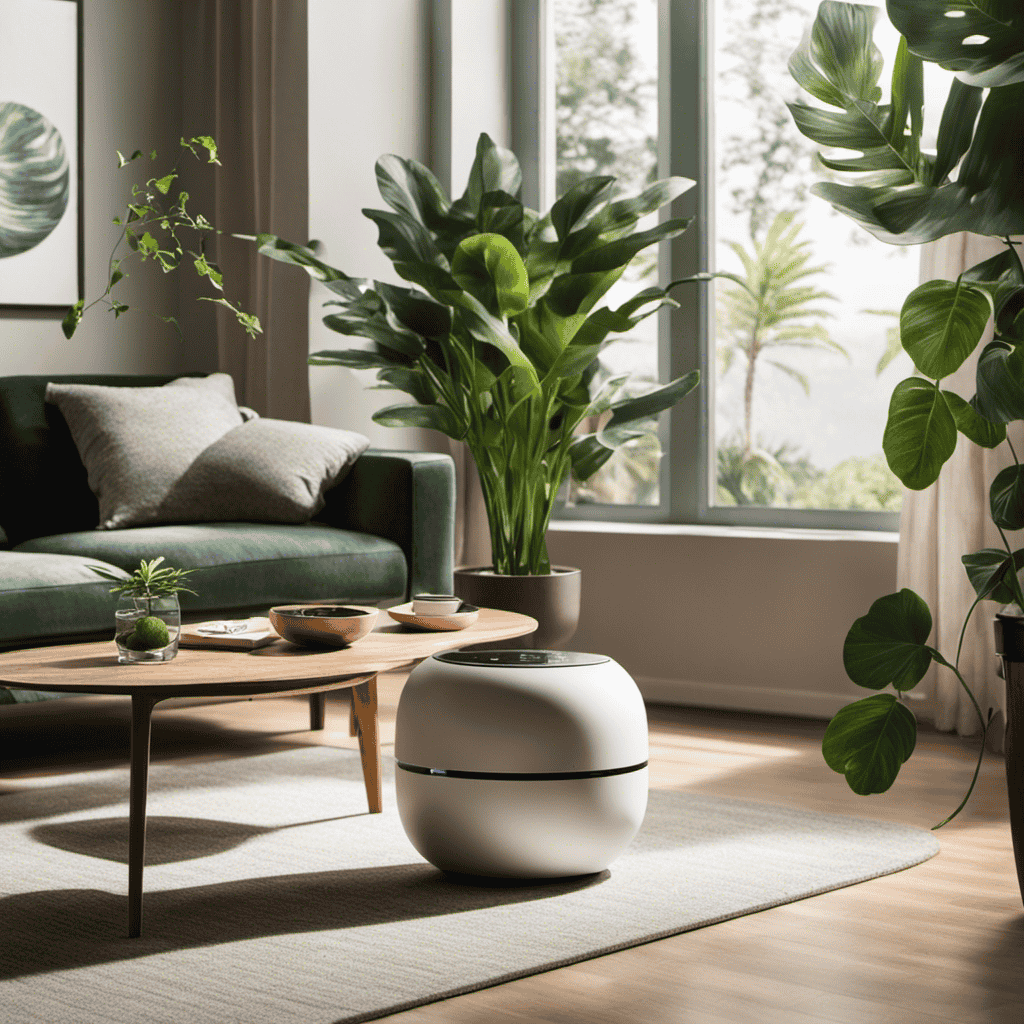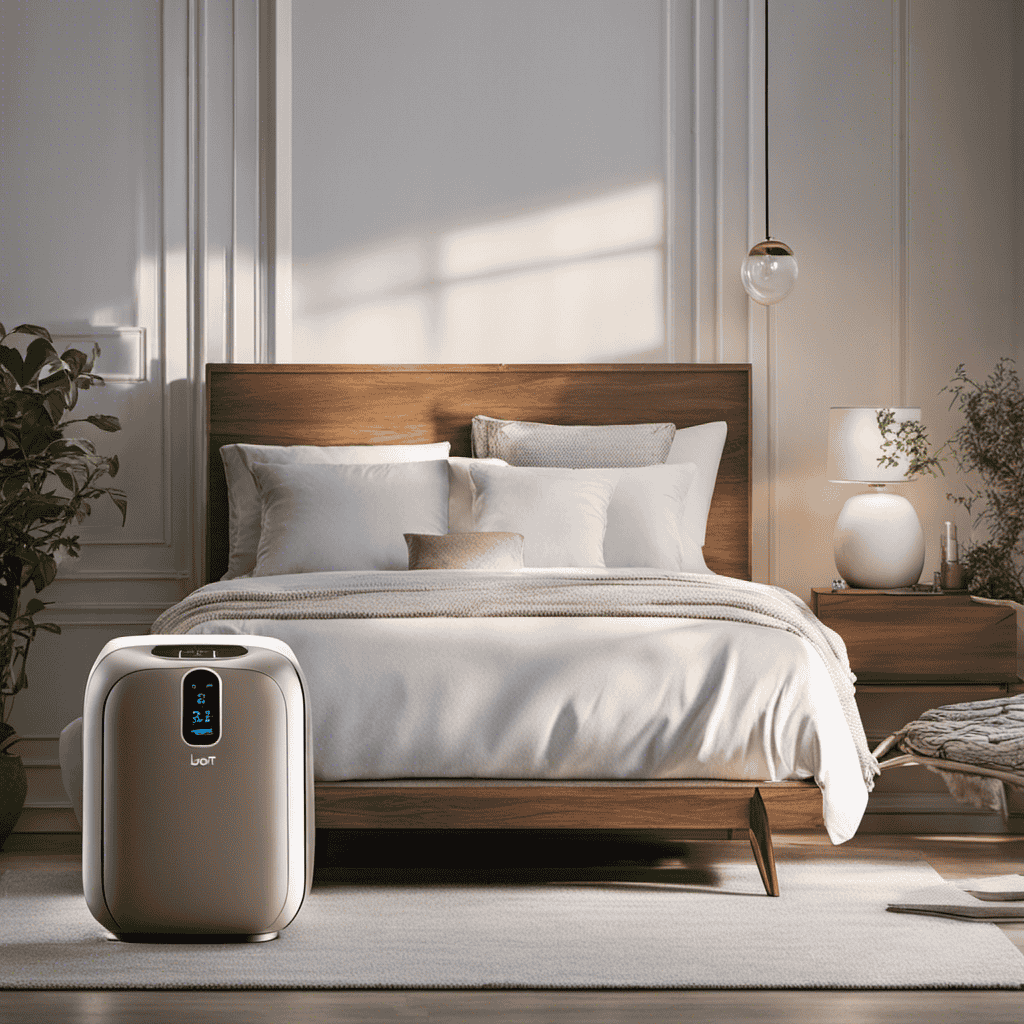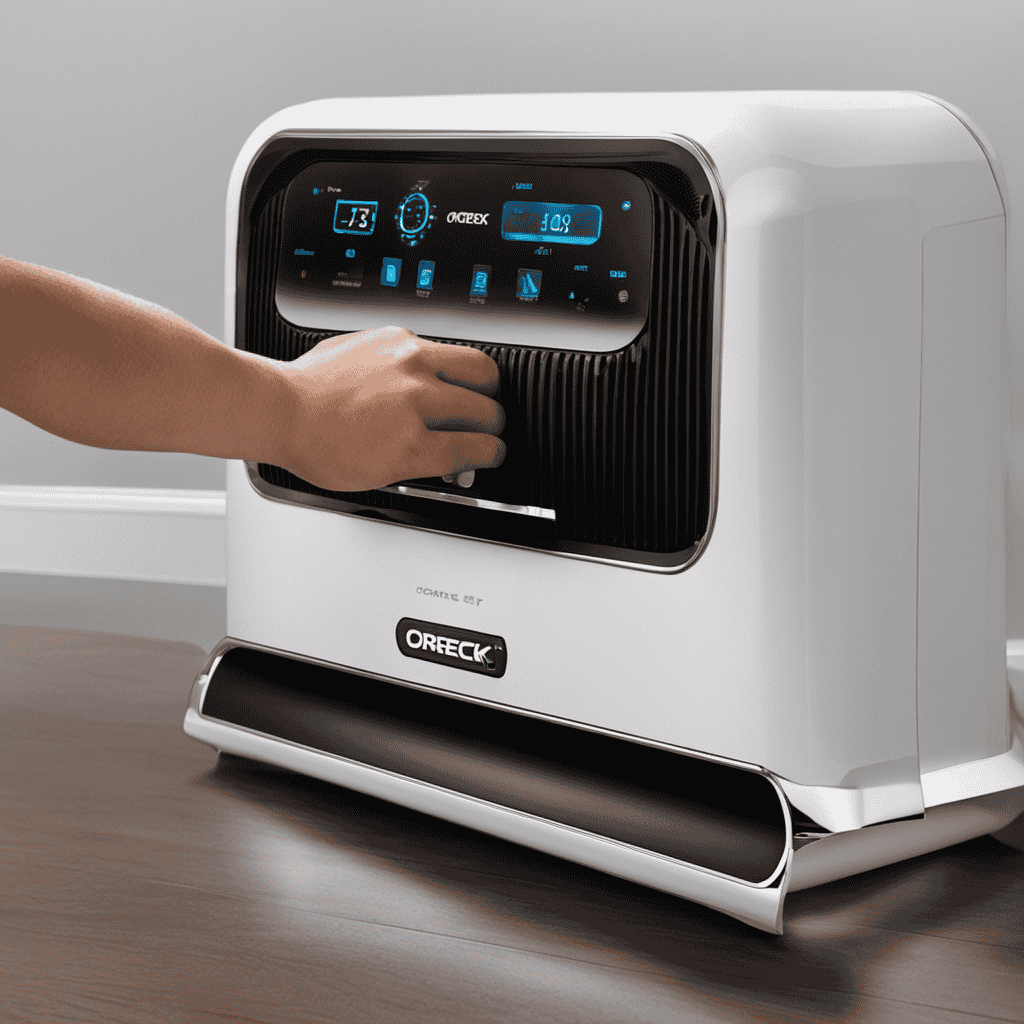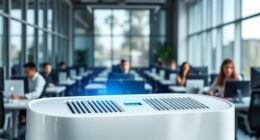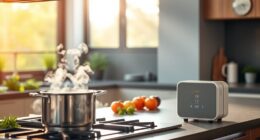I have discovered that selecting the top air purifier involves considering different types and factors, such as HEPA filters, activated carbon, and UV-C technology. The choices can be quite overwhelming.
Whether you need one for a large room or a small space, it’s important to find an air purifier that suits your specific needs.
In this article, we’ll explore the different types of air purifiers and provide objective analysis to help you make an informed decision.
Key Takeaways
- Consider the different types of air purifiers and their filter types for effectiveness and maintenance.
- Take into account the room size compatibility and noise levels of air purifiers.
- HEPA air purifiers are highly efficient at capturing allergens and fine particles, improving air quality and reducing allergy and asthma symptoms.
- Compare the cost and affordability of different air purifier models, including initial cost and filter replacement costs per year.
Types of Air Purifiers
There’s a variety of air purifiers available on the market. When considering which one to choose, it’s important to take into account factors such as filter maintenance and energy consumption.
Filter maintenance is crucial for the effectiveness of an air purifier. Regularly cleaning or replacing the filters ensures that they can efficiently trap and remove pollutants from the air. Some air purifiers even come with filter replacement indicators, making it easier to know when it’s time for a change.
Energy consumption is another important aspect to consider. Look for air purifiers that are energy-efficient and have low power consumption. This not only helps to reduce electricity bills but also minimizes the environmental impact.
Factors to Consider When Choosing an Air Purifier
When choosing an air purifier, it’s important to consider the different filter types available and how they compare in terms of effectiveness. Some common filter types include HEPA filters, activated carbon filters, and electrostatic filters.
Additionally, it’s crucial to determine the compatibility of the air purifier with the size of the room you intend to use it in, as different models have different coverage areas.
Filter Types Comparison
The most effective air purifiers use different filter types to remove pollutants from the air. When comparing filter types, it’s important to consider the benefits and drawbacks of each option. Here is a comparison of the popular filter types:
-
HEPA vs. Activated Carbon: HEPA filters are highly efficient at trapping particles as small as 0.3 microns, while activated carbon filters excel at removing odors and chemicals from the air.
-
UV-C vs. Ionizers: UV-C technology uses ultraviolet light to kill bacteria and viruses, while ionizers release negatively charged ions to attract and neutralize airborne pollutants.
-
HEPA filters are best for capturing allergens and fine particles, making them ideal for those with respiratory issues.
-
Activated carbon filters are great for removing odors and chemicals, making them suitable for kitchens and homes with pets.
-
UV-C technology is effective against bacteria and viruses, making it beneficial for individuals concerned about germs.
Understanding the pros and cons of each filter type will help you choose the right air purifier for your needs.
Now, let’s dive into the next section about ‘room size compatibility‘.
Room Size Compatibility
UV-C technology and ionizers are two different types of air purifiers that are suitable for different room sizes. UV-C air purifiers are effective in rooms up to 200 square feet, making them ideal for bedrooms, offices, or small living spaces. On the other hand, ionizers are designed to clean the air in larger areas, typically ranging from 300 to 500 square feet. This makes them a better choice for larger rooms, such as living rooms or open-concept spaces.
When choosing an air purifier, it’s important to consider the square footage of the space you want to purify. In addition to room size compatibility, noise levels should also be taken into account. UV-C air purifiers are generally quieter than ionizers, making them a more suitable option for noise-sensitive environments like bedrooms or offices where a quiet environment is desired.
HEPA Air Purifiers
When it comes to air purifiers, one of the key factors to consider is the effectiveness of the HEPA filtration system. HEPA filters are known for their ability to capture small particles, such as dust, pollen, and pet dander, providing cleaner and healthier air.
However, it is also important to consider the cost and affordability of HEPA air purifiers, as they can vary widely depending on the brand and features.
HEPA Filtration Effectiveness
You should consider the HEPA filtration effectiveness when choosing the best air purifier. HEPA filters are highly efficient at removing airborne particles, including dust, pollen, pet dander, mold spores, and even some bacteria and viruses.
Here are some reasons why HEPA filtration is important for clean indoor air:
- Removes up to 99.97% of particles as small as 0.3 microns
- Reduces indoor air pollution, which can cause respiratory issues
- Improves indoor air quality, leading to better overall health
- Helps alleviate allergy and asthma symptoms
- Creates a cleaner and fresher living environment
Cost and Affordability
If you’re on a tight budget, it’s important to consider the cost and affordability of an air purifier. To help you make an informed decision, let’s compare the cost of three popular air purifiers:
| Air Purifier Model | Initial Cost | Filter Replacement Cost per Year |
|---|---|---|
| Model A | $100 | $50 |
| Model B | $150 | $30 |
| Model C | $200 | $20 |
As you can see from the table, Model A has the lowest initial cost but has higher filter replacement costs per year. Model B has a slightly higher initial cost but lower filter replacement costs, making it more affordable in the long run. Model C, although the most expensive initially, has the lowest filter replacement costs, making it the most affordable option over time.
Considering the cost comparison and long-term affordability, it’s essential to factor in both the initial cost and ongoing maintenance expenses when choosing an air purifier that fits your budget.
Activated Carbon Air Purifiers
Look for activated carbon air purifiers to effectively remove odors and chemicals from your indoor air. Activated carbon filters have numerous benefits when it comes to improving indoor air quality. Here are some reasons why you should consider using activated carbon filters:
-
Eliminates unpleasant odors: Activated carbon filters can effectively neutralize and eliminate various types of odors, including smoke, pet odors, and cooking smells.
-
Removes harmful chemicals: These filters are designed to adsorb harmful chemicals and volatile organic compounds (VOCs) that can be found in indoor air, such as formaldehyde and benzene.
-
Enhances respiratory health: By trapping and removing airborne particles, activated carbon filters can help reduce the risk of respiratory issues and allergies.
-
Improves overall air quality: With their ability to remove odors and chemicals, activated carbon filters contribute to creating a healthier and more pleasant indoor environment.
-
Easy to maintain: Activated carbon filters are typically low maintenance and can be easily replaced when necessary.
Transitioning to the subsequent section about UV-C air purifiers, let’s explore another effective solution for improving indoor air quality.
UV-C Air Purifiers
When it comes to UV-C air purifiers, it’s important to understand their effectiveness and how they work.
UV-C light is known for its ability to kill harmful bacteria and viruses, making it an effective tool for improving indoor air quality.
Additionally, there are various models available in the market, so choosing the right one that suits your needs and preferences is crucial for reaping the health benefits of UV-C technology.
UV-C Effectiveness Explained
You should consider how effective UV-C is in purifying the air. UV-C, a type of ultraviolet light, has been shown to be highly effective in killing germs, viruses, and bacteria in the air. Here are some key points to consider:
-
UV-C technology is safe when used properly, as it is contained within the air purifier and does not emit harmful radiation.
-
UV-C air purifiers can eliminate up to 99.9% of airborne contaminants, providing cleaner and healthier air.
-
UV-C is particularly effective against mold spores, which can cause allergies and respiratory issues.
-
Unlike HEPA filters, which only trap particles, UV-C technology actively destroys microorganisms, preventing them from reproducing.
-
UV-C air purifiers are low maintenance and cost-effective, as they do not require frequent filter replacements.
Health Benefits of UV-C
To maximize the health benefits of UV-C, it’s important to ensure that the air purifier is equipped with a UV-C technology that actively destroys germs and bacteria in the air. UV-C technology is known for its effectiveness in killing microorganisms, but there are some safety concerns to consider.
Direct exposure to UV-C light can be harmful to humans and pets, so it’s crucial to choose an air purifier that has safety features in place, such as shields or timers. UV-C technology offers an additional layer of protection compared to HEPA filters alone, as it can target and eliminate airborne pathogens that may not be captured by the filter.
However, it’s important to note that UV-C technology should not be relied upon as the sole method of air purification. A combination of UV-C technology and HEPA filtration can provide the best results in keeping the air clean and healthy.
When choosing the right model, it’s essential to consider the room size, filtration efficiency, and maintenance requirements.
Choosing the Right Model
Now that we understand the health benefits of UV-C in air purifiers, let’s talk about choosing the right model for your needs.
One important factor to consider is the room layout. Different air purifiers are designed for different room sizes, so it’s crucial to choose one that can effectively cover the square footage of your space.
Additionally, noise level is another key consideration. If you’re planning to use the air purifier in a bedroom or office, you’ll want a model that operates quietly, allowing you to work or sleep without any disruptions.
To help you make an informed decision, here are five key points to keep in mind:
- Room size: Choose an air purifier that matches the square footage of your room.
- Noise level: Consider the decibel rating to ensure a quiet operation.
- Filter type: Look for models with HEPA or activated carbon filters for maximum effectiveness.
- Energy efficiency: Opt for an energy-efficient model to save on electricity bills.
- Additional features: Some air purifiers offer features like air quality sensors or remote control for added convenience.
Considering these factors will help you find the right air purifier that suits your room layout and noise level preferences.
Ionizers and Ozone Generators
Ionizers and ozone generators are two types of air purifiers commonly used to remove pollutants from the air. While both devices aim to improve indoor air quality, there are important differences between them.
Ionizers work by releasing negative ions into the air, which attach to pollutants and cause them to fall to the ground. On the other hand, ozone generators produce ozone, a gas that reacts with pollutants and neutralizes them.
However, it is essential to consider the health risks associated with these devices. Ionizers can generate ozone as a byproduct, which can lead to respiratory issues and worsen asthma symptoms. Ozone generators, when used improperly, can produce high levels of ozone that can be harmful to human health.
Therefore, it is crucial to carefully assess the potential health risks before using ionizers or ozone generators as air purifiers.
Smart Air Purifiers
Smart air purifiers use advanced technology to monitor and improve indoor air quality. These innovative devices offer a range of benefits for homeowners, including smart home integration and precise air quality monitoring.
Here are five reasons why smart air purifiers are a worthwhile investment:
-
Real-time air quality data: Smart purifiers continuously monitor the air and provide up-to-date information on pollutants and allergens present in your home.
-
Automatic adjustments: They can adjust their settings based on the detected air quality, ensuring optimal purification at all times.
-
Smart home integration: Many smart air purifiers can be connected to your home automation system, allowing you to control them remotely through your smartphone or voice assistants like Alexa or Google Assistant.
-
Customizable schedules: You can easily set specific purification schedules to match your daily routine and ensure clean air when you need it most.
-
Energy efficiency: Smart purifiers are designed to be energy-efficient, saving you money on electricity bills while keeping the air in your home clean and fresh.
With their advanced features and convenience, smart air purifiers are an excellent addition to any home, providing cleaner and healthier indoor air.
Air Purifiers for Allergies
When it comes to air purifiers for allergies, two key points to consider are the top allergy-friendly purifiers and the effective purification methods they employ.
It’s important to choose a purifier that is specifically designed to address allergens such as pollen, dust mites, pet dander, and mold spores.
Additionally, effective purification methods such as HEPA filtration, activated carbon, and UV-C light can help to remove these allergens and improve indoor air quality.
Top Allergy-Friendly Purifiers
Out of all the top allergy-friendly purifiers, the Honeywell True HEPA Allergen Remover is highly recommended. This purifier is effective in reducing allergens such as mold spores and pollen, making it ideal for individuals with mold allergies and pollen allergies.
Here are five reasons why the Honeywell True HEPA Allergen Remover stands out:
- It features a True HEPA filter that captures up to 99.97% of airborne particles as small as 0.3 microns.
- The activated carbon pre-filter helps eliminate common household odors.
- It has a recommended room size of up to 465 square feet, providing coverage for large spaces.
- The unit operates quietly, allowing for undisturbed sleep and relaxation.
- The filter replacement indicator ensures timely maintenance for optimal performance.
With its impressive features and performance, the Honeywell True HEPA Allergen Remover is an excellent choice for those seeking relief from mold and pollen allergies.
Transitioning to the subsequent section, let’s explore the effective purification methods used in these top-notch purifiers.
Effective Purification Methods
After considering the top allergy-friendly air purifiers, it’s important to understand the effective purification methods they use.
One common method is High-Efficiency Particulate Air (HEPA) filtration, which can remove up to 99.97% of airborne particles as small as 0.3 microns. This is particularly beneficial for those with allergies or asthma, as it helps to reduce the presence of allergens and irritants in the air.
Another effective method is activated carbon filtration, which can eliminate odors and trap volatile organic compounds (VOCs).
Additionally, some purifiers use ultraviolet (UV) light to kill bacteria and viruses.
To maintain optimal performance, it is crucial to regularly clean and replace the filters in your air purifier. By doing so, you can ensure that your purifier continues to effectively remove pollutants and provide you with the benefits of clean air.
Air Purifiers for Asthma
I’ve heard that air purifiers can be helpful for people with asthma. As someone who has asthma, I understand the importance of clean air in managing my symptoms.
Air purifiers have become popular in recent years for their ability to filter out pollutants and improve indoor air quality.
When it comes to air purifiers for children, it is crucial to choose models that are specifically designed for their needs. These purifiers often have child-friendly features like quiet operation and easy-to-use controls.
On the other hand, air purifiers for office spaces should prioritize high efficiency and a large coverage area to effectively filter out pollutants in a larger environment.
Overall, air purifiers can make a significant difference in creating a healthier and safer indoor environment for both children and office workers alike.
- Child-friendly features for air purifiers
- Quiet operation for a peaceful environment
- Easy-to-use controls for hassle-free operation
- High efficiency to effectively filter pollutants
- Large coverage area for office spaces
Air Purifiers for Pet Owners
As a pet owner, it’s important to choose an air purifier that effectively reduces pet dander and odors in the home. Pet friendly air purifiers are specifically designed to tackle these common issues faced by pet owners. These purifiers use advanced filtration systems to capture pet hair, allergens, and unpleasant smells, improving the overall air quality in your home.
The benefits of air purifiers for pet owners are numerous. They help alleviate allergies and respiratory issues caused by pet dander, making it easier for both you and your furry friend to breathe. Additionally, they eliminate pet odors, leaving your home smelling fresh and clean. By investing in a pet friendly air purifier, you can create a healthier and more comfortable environment for both you and your beloved pets.
Speaking of odors, let’s now explore air purifiers for smoke and odor removal.
Air Purifiers for Smoke and Odor Removal
To effectively remove smoke and odors from your home, consider using an air purifier specifically designed for these purposes. Air purifiers for cigarette smoke and odor elimination can greatly improve the air quality in your living space. Here are five reasons why investing in the best air purifier for odor elimination is a smart choice:
- Eliminates smoke particles and odors, making your home smell fresh and clean.
- Reduces the risk of respiratory issues caused by inhaling smoke and harmful chemicals.
- Removes airborne pollutants such as volatile organic compounds (VOCs) commonly found in cigarette smoke.
- Helps eliminate lingering odors from cooking, pets, or other sources.
- Provides a healthier living environment for you and your family, free from harmful pollutants.
Air Purifiers for Large Rooms
If you have a large room that needs clean air, consider using an air purifier specifically designed for larger spaces. These air purifiers are capable of covering a greater square footage and can effectively remove pollutants and allergens from the air.
When choosing an air purifier for a large room, it is essential to consider its room size compatibility. Look for models that are recommended for the square footage of your room to ensure optimal performance.
Additionally, it is important to compare the cost of different air purifiers. While larger air purifiers may have a higher upfront cost, they often have longer filter life and lower maintenance costs, making them more cost-effective in the long run.
Air Purifiers for Small Spaces
When choosing an air purifier for small spaces, it’s important to consider its compact size and efficiency. Compact air purifiers are designed to fit seamlessly into tight spaces, making them ideal for bedrooms, offices, and small living areas. Portable air purifiers are also a great option for those who need to move their purifier from room to room.
Here are five key benefits of compact and portable air purifiers:
- Convenience: Easily move the purifier wherever you need it most.
- Efficiency: Effectively remove airborne pollutants and allergens from the air.
- Space-saving: Take up minimal space in your room without sacrificing performance.
- Quiet operation: Enjoy clean air without the distraction of loud noise.
- Energy-saving: Use less energy compared to larger models, saving you money in the long run.
Consider these factors when choosing the best air purifier for your small space.
Air Purifiers With Multiple Filtration Layers
Consider the benefits of air purifiers with multiple filtration layers for cleaner and fresher indoor air. These advanced air purifiers are especially beneficial for children, as they help remove pollutants and allergens from the air, creating a healthier environment for them to breathe. Additionally, air purifiers with smart sensors are equipped with technology that detects and monitors the air quality in real-time. This allows the purifier to automatically adjust its settings based on the air quality, ensuring optimal performance at all times. To illustrate the effectiveness of air purifiers with multiple filtration layers, here is a table showcasing some popular models and their key features:
| Model | Filtration Layers | Smart Sensor Technology |
|---|---|---|
| A | 3 | Yes |
| B | 4 | Yes |
| C | 5 | Yes |
| D | 3 | No |
Investing in an air purifier with multiple filtration layers and smart sensors can greatly improve the indoor air quality, making your home a safer and healthier space for your children.
Air Purifiers With Quiet Operation
To ensure a peaceful and noise-free environment, you’ll appreciate air purifiers with quiet operation. These devices not only improve the quality of the air you breathe but also provide a serene atmosphere in your home or workspace.
The benefits of air purifiers with quiet operation include:
- Enhanced relaxation: With minimal noise, you can unwind and enjoy a peaceful environment.
- Improved sleep: The quiet operation allows you to sleep undisturbed, promoting better rest and rejuvenation.
- Increased focus: A noise-free environment helps you concentrate better, boosting productivity.
- Reduced stress: The absence of loud noises creates a calm atmosphere, reducing stress levels.
- Enhanced well-being: Quiet air purifiers contribute to a sense of well-being, improving overall happiness and contentment.
These benefits are achieved through the implementation of noise reduction technology, which ensures that the air purifier operates quietly without compromising its effectiveness in purifying the air.
Frequently Asked Questions
Can Air Purifiers Help With Reducing the Spread of Airborne Diseases Like Covid-19?
Air purifiers can help reduce the spread of airborne diseases like COVID-19. They are effective in filtering out respiratory viruses and can be beneficial in public spaces during a pandemic. However, their effectiveness may be limited in certain situations.
Are Air Purifiers Suitable for Use in Offices or Commercial Spaces?
Air purifiers are suitable for offices and commercial spaces. They can improve air quality, reducing the spread of airborne diseases. In schools, they can enhance student health, while hospitals benefit from cleaner air for patients.
How Often Do the Filters in Air Purifiers Need to Be Replaced?
Air filters in air purifiers should be replaced regularly, typically every 3-6 months. Signs that indicate the need for replacement include reduced air flow, increased dust accumulation, and a decrease in air purifier performance.
Can Air Purifiers Remove Volatile Organic Compounds (Vocs) From the Air?
Yes, air purifiers can remove volatile organic compounds (VOCs) from the air. They are beneficial for allergy relief and the efficiency of VOC removal varies among different types of air purifiers.
Do Air Purifiers Have Any Negative Side Effects on Health or the Environment?
Air purifiers can have negative effects on respiratory health, such as dryness and irritation of the throat and eyes. Additionally, they contribute to the environmental impact by consuming electricity and generating waste.
Conclusion
Well, after all of that research and analysis, it seems that there really is no ‘best’ air purifier. Each type has its own strengths and weaknesses, and what works for one person may not work for another.
It’s almost comical how we spend so much time trying to find the perfect solution, only to realize that there isn’t one. But hey, at least we now have a better understanding of the different types of air purifiers and the factors to consider when choosing one.
So, let’s embrace the irony and keep searching for that elusive ‘best’ air purifier, knowing that we may never find it.
